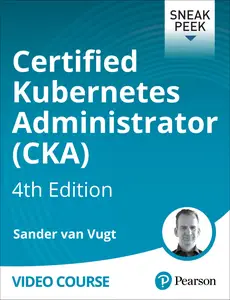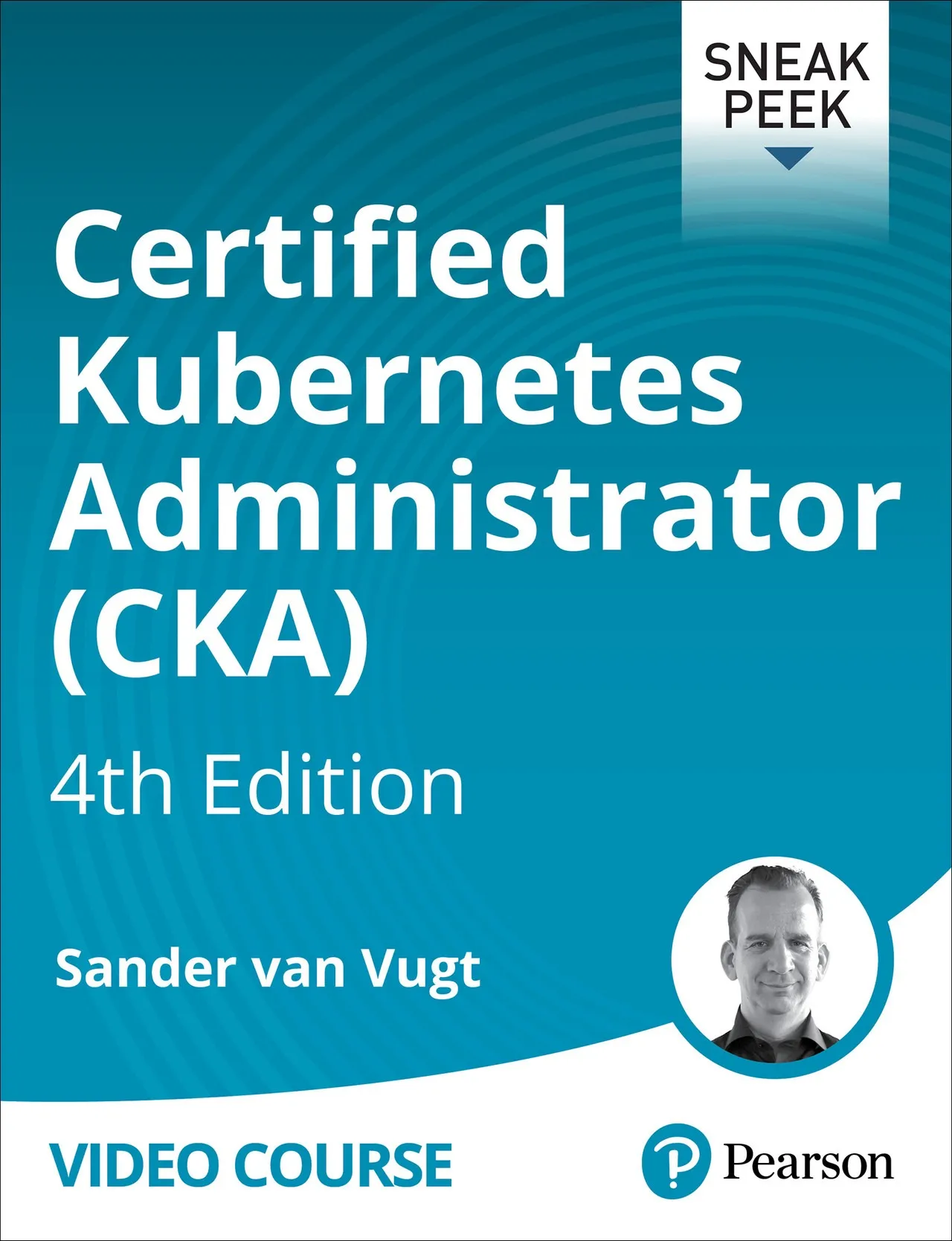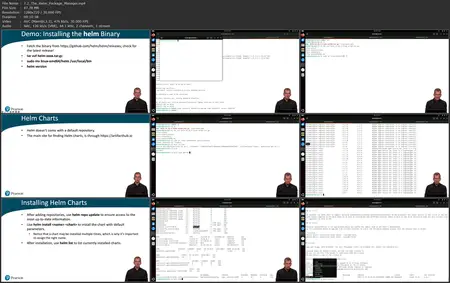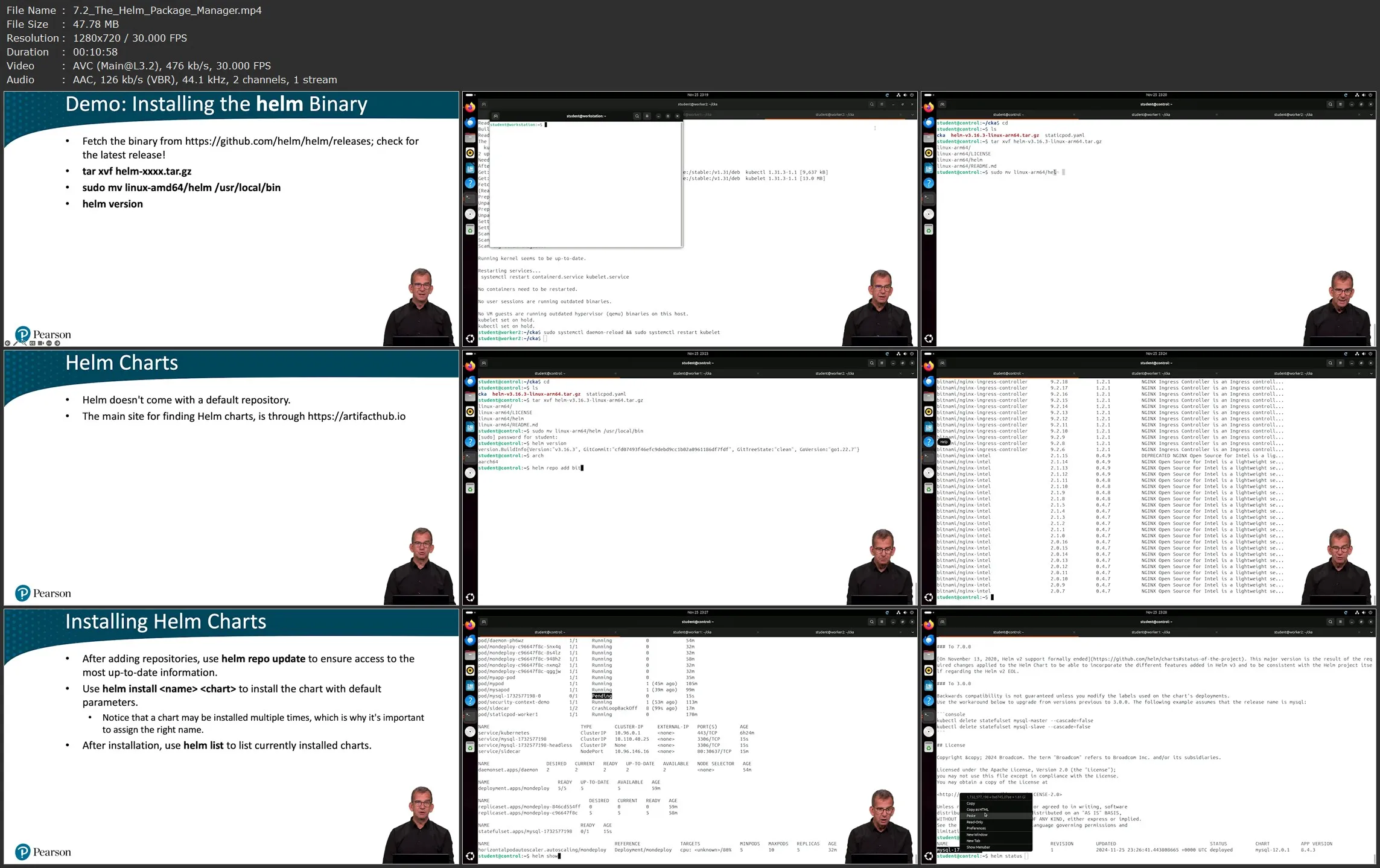Certified Kubernetes Administrator (CKA), 4th Edition
ISBN: 9780135375129 | .MP4, AVC, 1280x720, 30 fps | English, AAC, 2 Ch | 4h 47m | 1.22 GB
Instructor: Sander van Vugt
ISBN: 9780135375129 | .MP4, AVC, 1280x720, 30 fps | English, AAC, 2 Ch | 4h 47m | 1.22 GB
Instructor: Sander van Vugt
The Sneak Peek program provides early access to Pearson video products and is exclusively available to subscribers. Content for titles in this program is made available throughout the development cycle, so products may not be complete, edited, or finalized, including video post-production editing.
Introduction
Certified Kubernetes Administrator (CKA): Introduction
Module 1: Cluster Architecture, Installation, and Configuration
Module Introduction
Lesson 1: Understanding Kubernetes Architecture
Learning objectives
1.1 Vanilla Kubernetes and the Ecosystem
1.2 Running Kubernetes in Cloud or on Premises
1.3 Kubernetes Distributions
1.4 Kubernetes Node Roles
Lesson 2: Creating a Kubernetes Cluster with kubeadm
Learning objectives
2.1 Understanding Cluster Node Requirements
2.2 Provisioning an Infrastructure for Hosting Kubernetes
2.3 Installation Procedure Overview
2.5 Installing CRI and Tools
2.6 Using kubeadm init
2.7 Configuring the Kubernetes Client
2.8 Setting up Node Networking
2.9 Adding Nodes to the Cluster
Lesson 2 Lab: Building a Kubernetes Cluster
Lesson 2 Lab Solution: Building a Kubernetes Cluster
Lesson 3: Managing Kubernetes Clusters
Learning objectives
3.1 Analyzing Cluster Nodes
3.2 Using crictl to Manage Node Containers
3.3 Running Static Pods
3.4 Managing Node State
3.5 Managing Node Services
Lesson 3 Lab: Running Static Pods
Lesson 3 Lab Solution: Running Static Pods
Lesson 4: Performing Node Maintenance Tasks
Learning objectives
4.1 Using Metrics Server to Monitor Node and Pod Performance
4.2 Backing up the Etcd
4.3 Restoring the Etcd
4.4 Performing Cluster Node Upgrades
4.5 Performing Cluster Worker Upgrades
4.6 Understanding Cluster High Availability Options
4.7 Setting up a Highly Available Kubernetes Cluster
Lesson 4 Lab: Etcd Backup and Restore
Lesson 4 Lab Solution: Etcd Backup and Restore
Lesson 5: Managing Security Settings
Learning objectives
5.1 Understanding API Access
5.2 Managing Security Context
5.3 Users, ServiceAccounts, and API Access
5.4 Understanding Role Based Access Control (RBAC)
5.5 Setting up RBAC for ServiceAccounts
5.6 ClusterRoles and ClusterRoleBindings
5.7 Setting up RBAC for Users
Lesson 5 Lab: Managing Security
Lesson 5 Lab Solution: Managing Security
Module 2: Workloads and Scheduling
Module Introduction
Lesson 6: Deploying Kubernetes Applications
Learning objectives
6.1 Using Deployments
6.2 Running Agents with DaemonSets
6.4 The Case for Running Individual Pods
6.5 Managing Pod Initialization
6.6 Scaling Applications
6.8 Using Sidecar Containers for Application Logging
Lesson 6 Lab: Running a DaemonSet
Lesson 6 Lab Solution: Running a DaemonSet
Lesson 7: Using Templating Tools
Learning objectives
7.1 Running Applications from YAML Files
7.2 The Helm Package Manager
7.4 Managing Applications with Helm
7.5 Using Kustomize
Lesson 7 Lab: Managing Applications with Helm
Lesson 7 Lab Solution: Managing Applications with Helm
Lesson 8: Managing Scheduling
Learning objectives
8.1 Exploring the Scheduling Process
8.2 Setting Node Preferences
8.3 Managing Affinity and anti-Affinity Rules
8.4 Managing Taints and Tolerations
8.5 Configuring Resource Limits and Requests
8.6 Setting Namespace Quota
8.7 Configuring LimitRange
8.8 Configuring Pod Priorities
Lesson 8 Lab: Configuring Taints
Lesson 8 Lab Solution: Configuring Taints
Certified Kubernetes Administrator (CKA): Introduction
Module 1: Cluster Architecture, Installation, and Configuration
Module Introduction
Lesson 1: Understanding Kubernetes Architecture
Learning objectives
1.1 Vanilla Kubernetes and the Ecosystem
1.2 Running Kubernetes in Cloud or on Premises
1.3 Kubernetes Distributions
1.4 Kubernetes Node Roles
Lesson 2: Creating a Kubernetes Cluster with kubeadm
Learning objectives
2.1 Understanding Cluster Node Requirements
2.2 Provisioning an Infrastructure for Hosting Kubernetes
2.3 Installation Procedure Overview
2.5 Installing CRI and Tools
2.6 Using kubeadm init
2.7 Configuring the Kubernetes Client
2.8 Setting up Node Networking
2.9 Adding Nodes to the Cluster
Lesson 2 Lab: Building a Kubernetes Cluster
Lesson 2 Lab Solution: Building a Kubernetes Cluster
Lesson 3: Managing Kubernetes Clusters
Learning objectives
3.1 Analyzing Cluster Nodes
3.2 Using crictl to Manage Node Containers
3.3 Running Static Pods
3.4 Managing Node State
3.5 Managing Node Services
Lesson 3 Lab: Running Static Pods
Lesson 3 Lab Solution: Running Static Pods
Lesson 4: Performing Node Maintenance Tasks
Learning objectives
4.1 Using Metrics Server to Monitor Node and Pod Performance
4.2 Backing up the Etcd
4.3 Restoring the Etcd
4.4 Performing Cluster Node Upgrades
4.5 Performing Cluster Worker Upgrades
4.6 Understanding Cluster High Availability Options
4.7 Setting up a Highly Available Kubernetes Cluster
Lesson 4 Lab: Etcd Backup and Restore
Lesson 4 Lab Solution: Etcd Backup and Restore
Lesson 5: Managing Security Settings
Learning objectives
5.1 Understanding API Access
5.2 Managing Security Context
5.3 Users, ServiceAccounts, and API Access
5.4 Understanding Role Based Access Control (RBAC)
5.5 Setting up RBAC for ServiceAccounts
5.6 ClusterRoles and ClusterRoleBindings
5.7 Setting up RBAC for Users
Lesson 5 Lab: Managing Security
Lesson 5 Lab Solution: Managing Security
Module 2: Workloads and Scheduling
Module Introduction
Lesson 6: Deploying Kubernetes Applications
Learning objectives
6.1 Using Deployments
6.2 Running Agents with DaemonSets
6.4 The Case for Running Individual Pods
6.5 Managing Pod Initialization
6.6 Scaling Applications
6.8 Using Sidecar Containers for Application Logging
Lesson 6 Lab: Running a DaemonSet
Lesson 6 Lab Solution: Running a DaemonSet
Lesson 7: Using Templating Tools
Learning objectives
7.1 Running Applications from YAML Files
7.2 The Helm Package Manager
7.4 Managing Applications with Helm
7.5 Using Kustomize
Lesson 7 Lab: Managing Applications with Helm
Lesson 7 Lab Solution: Managing Applications with Helm
Lesson 8: Managing Scheduling
Learning objectives
8.1 Exploring the Scheduling Process
8.2 Setting Node Preferences
8.3 Managing Affinity and anti-Affinity Rules
8.4 Managing Taints and Tolerations
8.5 Configuring Resource Limits and Requests
8.6 Setting Namespace Quota
8.7 Configuring LimitRange
8.8 Configuring Pod Priorities
Lesson 8 Lab: Configuring Taints
Lesson 8 Lab Solution: Configuring Taints





